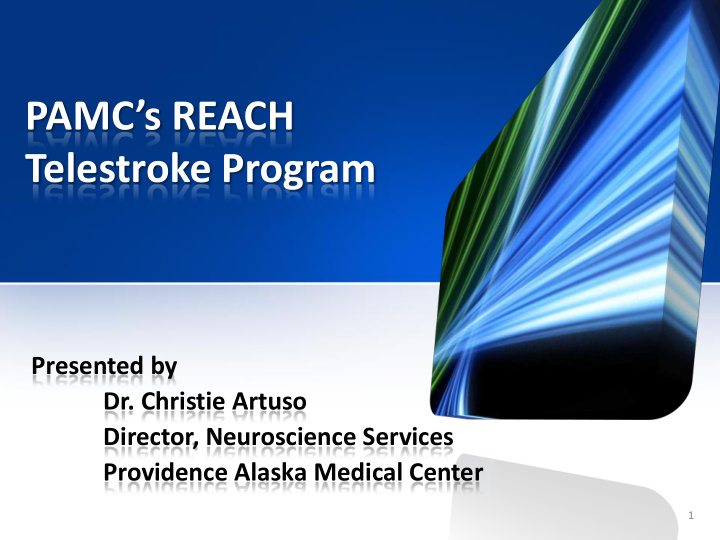



PAMC’s REACH Telestroke Program Presented by Dr. Christie Artuso Director, Neuroscience Services Providence Alaska Medical Center 1
Why Telestroke? • Internationally accepted method for delivery of care • Improved access to qualified care {specialists} – Decreased transportation costs – Improved care decisions = decreased cost of care • Improved quality – improved patient outcomes – Monitoring – E-consultation with recommendation • Education and training – Access to conferences / expert consultation / improved practice at local site 2
Program Overview • Program Type – Provider to Patient – Collaborative with Provider to Provider • Initial Implementation – Advanced Primary Stroke Center Designation • May, 2008 – Technology and Training • February, 2009 – May, 2009 – Implementation 5 Spokes • May, 2008 – January, 2009 3
Program Overview • Technology Platform – REACHHealth, Inc Mobile Carts • Technology Support – Vendor supported with local liaisons 4
Program Overview • Locations – Bartlett Regional Hospital, Juneau, AK – Providence Kodiak Medical Center – Providence Valdez Medical Center – Providence Seward Medical and Care Center – Central Peninsula Hospital, Soldotna, AK 5
Local Implications • Impact on nursing / medical practice – Change in ‘how’ we deliver medical care • Change in ‘what’ we expect from the healthcare system • Changes in community perceptions {patient perceptions} • Changes in provider / nurse / patient relationship 7
Outcomes? • Successful implementation in 5 locations • Appropriate referrals to tertiary care facility • Decreased unnecessary transportation • Improved tPA [thrombolytic] treatment in State of Alaska to 4.7 percent (national average 2-3%) • Improved identification of stroke at spoke hospitals [education] 8
Key Program Challenges • Providing sustainable and qualified physician coverage with increased volume • Adding neurosurgery coverage for hemorrhagic stroke evaluation resulting in additional costs • Levels of reimbursement / cost of delivery – Liability • Reliable connectivity • Changing technology • Trust / Distrust 9
Future strategies? • Alaska Collaborative for Telehealth and Telemedicine (ACTT) • Alaska region initiative related to telehealth / telemedicine • Providence Health Services system wide initiative related to outreach with subdivision for telehealth / telemedicine • Robust evaluation of systems, reimbursement, infrastructure, resources, community needs 10
Summary……… Telemedicine will be a rapidly growing strategy for the delivery of healthcare throughout the United States and global communities. Through technology, access to specialized and acute care services will improve, the overall health of communities will improve and the way we deliver healthcare will change. 11
Recommend
More recommend